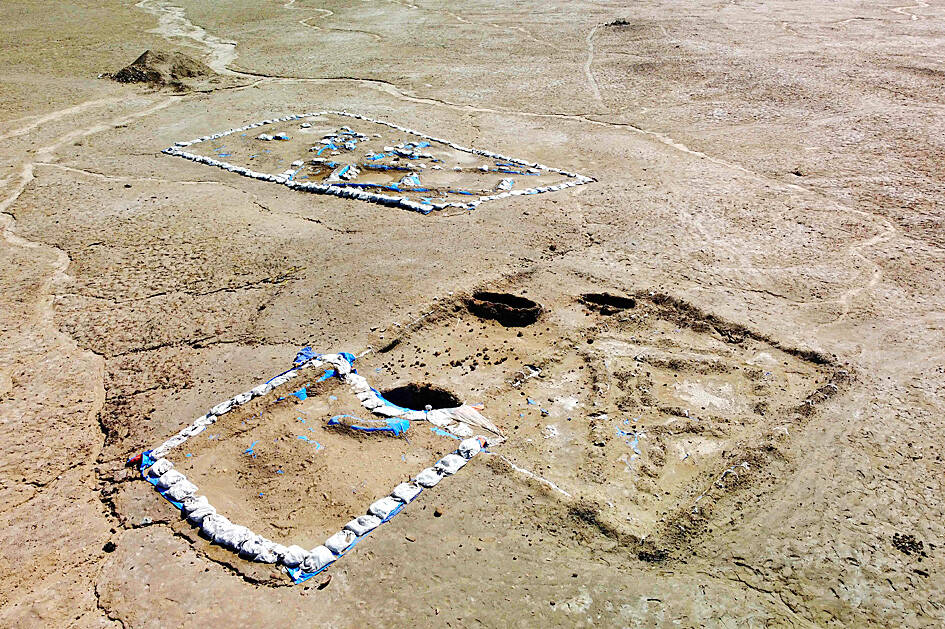Archeologists in southern Iraq have uncovered the remains of an ancient tavern that they hope will illuminate the lives of ordinary people in the world’s first cities.
The US-Italian team made the find in the ruins of Lagash, northeast of the modern city of Nasiriyah, which was already known to have been one of the first urban centers of the Sumerian civilization of ancient Iraq.
The joint team from the University of Pennsylvania and the University of Pisa discovered the remains of a primitive refrigeration system, a large oven, benches for diners and about 150 serving bowls.

Photo: AFP
Fish and animal bones were found in the bowls, alongside evidence of beer drinking, which was widespread among the Sumerians.
“So we’ve got the refrigerator, we’ve got the hundreds of vessels ready to be served, benches where people would sit ... and behind the refrigerator is an oven that would have been used ... for cooking food,” project director Holly Pittman told reporters. “What we understand this thing to be is a place where people — regular people — could come to eat and that is not domestic.”
“We call it a tavern because beer is by far the most common drink, even more than water, for the Sumerians,” she said, adding that in one of the temples excavated in the area “there was a beer recipe that was found on a cuneiform tablet.”
The world’s first cities are thought to have developed in what is now southern Iraq after agricultural surpluses from the domestication of the first crops allowed the emergence of new social classes not engaged directly in food production.
The Lagash area, close to the confluence of the Tigris and Euphrates rivers, was dubbed the “garden of the gods” by ancient people for its fertility and gave rise to a string of Sumerian cities dating back to the early dynastic period.
“Lagash was one of the important cities of southern Iraq,” Iraqi archeologist Baker Azab Wali told reporters, after working with the US-Italian team on the site.
“Its inhabitants depended on agriculture, livestock, fishing, but also on the exchange of goods,” he said.
Pittman said that the team was eager to learn more about the occupations of the people who used the tavern in its heyday in about 2700 BC to throw new light on the social structure of the cities.
Detailed analysis would need to be carried out on the samples taken during the excavations the team completed in November last year.
“There is so much that we do not know about this early period of the emergence of cities and that is what we are investigating,” she said.
“We hope to be able to characterize the neighborhoods and the kinds of occupation ... of the people that lived in this big city who were not the elite,” she added. “Most of the work done at the other sites focuses on kings and priests. And that is all very important, but the regular people are also important.”

Thousands gathered across New Zealand yesterday to celebrate the signing of the country’s founding document and some called for an end to government policies that critics say erode the rights promised to the indigenous Maori population. As the sun rose on the dawn service at Waitangi where the Treaty of Waitangi was first signed between the British Crown and Maori chiefs in 1840, some community leaders called on the government to honor promises made 185 years ago. The call was repeated at peaceful rallies that drew several hundred people later in the day. “This government is attacking tangata whenua [indigenous people] on all

RIGHTS FEARS: A protester said Beijing would use the embassy to catch and send Hong Kongers to China, while a lawmaker said Chinese agents had threatened Britons Hundreds of demonstrators on Saturday protested at a site earmarked for Beijing’s controversial new embassy in London over human rights and security concerns. The new embassy — if approved by the British government — would be the “biggest Chinese embassy in Europe,” one lawmaker said earlier. Protester Iona Boswell, a 40-year-old social worker, said there was “no need for a mega embassy here” and that she believed it would be used to facilitate the “harassment of dissidents.” China has for several years been trying to relocate its embassy, currently in the British capital’s upmarket Marylebone district, to the sprawling historic site in the

‘IMPOSSIBLE’: The authors of the study, which was published in an environment journal, said that the findings appeared grim, but that honesty is necessary for change Holding long-term global warming to 2°C — the fallback target of the Paris climate accord — is now “impossible,” according to a new analysis published by leading scientists. Led by renowned climatologist James Hansen, the paper appears in the journal Environment: Science and Policy for Sustainable Development and concludes that Earth’s climate is more sensitive to rising greenhouse gas emissions than previously thought. Compounding the crisis, Hansen and colleagues argued, is a recent decline in sunlight-blocking aerosol pollution from the shipping industry, which had been mitigating some of the warming. An ambitious climate change scenario outlined by the UN’s climate

A deluge of disinformation about a virus called hMPV is stoking anti-China sentiment across Asia and spurring unfounded concerns of renewed lockdowns, despite experts dismissing comparisons with the COVID-19 pandemic five years ago. Agence France-Presse’s fact-checkers have debunked a slew of social media posts about the usually non-fatal respiratory disease human metapneumovirus after cases rose in China. Many of these posts claimed that people were dying and that a national emergency had been declared. Garnering tens of thousands of views, some posts recycled old footage from China’s draconian lockdowns during the COVID-19 pandemic, which originated in the country in late